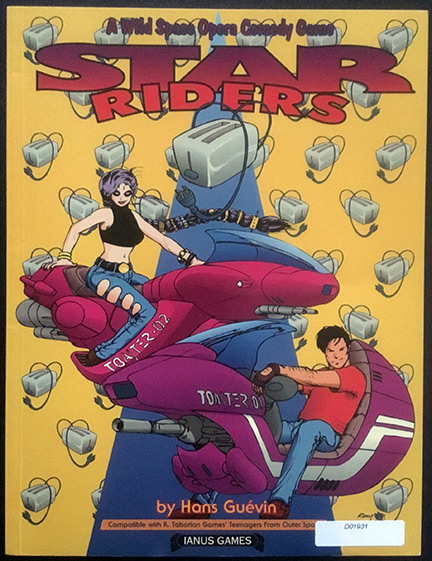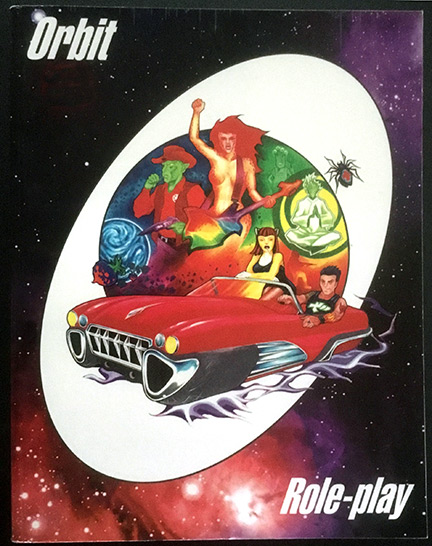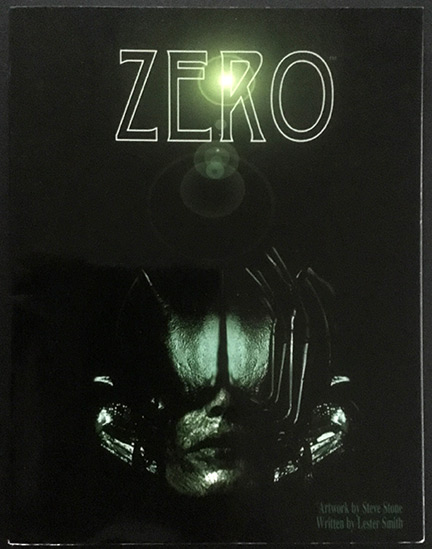This is part 9 in a series discussing forgotten RPGs (also see Part 1, Part 2, Part 3, Part 4, Part 5, Part 6, Part 7, and Part 8). That is, games most people have never heard of or that didn't last long on store shelves for one reason or another. This is another batch of sci-fi type games. Most of these games have been sitting on my shelf for years, mostly ebay finds to add to my collection.


1. Xenoforce (by Simon Parkinson; reproduced by Dragon Games in 1997?)

This spiral-bound game starts out with a full-color comic. I'm not generally a fan of that in an RPG, unless it's that sort of RPG. I don't think this is. The introduction touches on the setting, explaining the alien cover-up in Roswell and that Xenoforce was created as a worldwide agency to deal with such issues. Various branches and relations are discussed. After the usual talk of dice and record-keeping, we move onto characters. There are five abilities that max out at 90: strength, perception, constitution, agility, and influence. There are various methods for determining these values. Then we move on to major and minor skills, the former being expertise (base rating of 65) and the latter representing some knowledge (base rating of 40). Abilities also modify these values as per a chart, from -5 to +6 for major skills and -7 to +5 for minor skills. If you don't fill all the available skill slots, you get bonuses to the others. Using a skill is just a percentage roll for the skill rating. Combat works similarly, modifying the chances for range and cover, for example. There are special rules for grenades, automatic fire, falling, etc. I don't think it's as expansive as Bureau 13, but gets the job done. We finish off with information on aliens and a FAQ. The character sheet seems to be really well organized, allowing you to fill in all the needed numbers. There's also some reference sheets in the back. This is another game that doesn't offer anything for me today, but I probably would have tried it in the early 90s if it was around (it was not).




2. Twilight Imperium: The Role-Playing Game (by Todd Nilson, Jason S. Williams, and Darrell Hardy; published by Fantasy Flight Games in 1999)

While the Twilight Imperium boardgame has been very popular, I'm not sure the RPG was well-known, nor do I think it lasted long. Obviously, this takes place in the setting of the boardgame, so we are introduced to that in the beginning of the book, including various worlds and the species. That brings us to page 45 for character creation. The steps are clearly laid out. Characters have five personal statistics (1-20): body, ability, mind, education, and charisma. Skills are rated from 1 to 60, with points allocated depending on profession. Why is there an entire space between the skills for each profression? It spreads them out over too many columns and pages. Skill rolls are percentage-based, rolling under personal statistic plus skill rating. I'm not a fan of the combat system. Your attack roll is exactly the same as a skill roll. There is no opposing effect. Of course, you can always dodge, but that too is just a skill roll and it avoids all future attacks during the same turn. There are options to adjust combat percentages for range and cover, but that's about it. After this, the book moves onto discussing technology, weapons, and the more exotic stuff. Space travel and combat is next, following the same basic rules. The book is rounded out with a gamemaster's guide and sample adventure. When it comes down to it, this is a rather simple game for playing in the Twilight Imperium setting. I'm not sold on it though. It seems to be a child of the 90s in its simplicity, but to me, it fails to deliver on what could be an incredible gaming experience. It's also rather interesting to compare this game (and its system) to the publisher's current lineup of RPGs. They seem to be on opposite ends of the spectrum. Whether that's good or bad is for the reader to decide.




3. Star Riders (by Hans Guévin; published by Ianus Games in 1993)

This is billed as "a wild space opera comedy game" and compatible with R. Talsorian Games' Teenagers from Outer Space. Players portray Star Riders, which are sort of like hippies and bums in space. There's eight stats (1-6): smarts, bod, relationship with pals, luck, driving, looks, cool, and bonk (number of hits you can take). There's also knacks and powers. Doing things means rolling 1d6 and adding your relevant stat. Higher results win. That's it. The book discusses the setting, aliens, equipment, and wild stories (lots of scenarios). If you're looking for something less than serious, simple, and with lots of ideas for play, this is probably for you. It should be noted that Ianus Games is now Dream Pod 9, and Star Riders is available as a downloadable PDF.





4. Danger Quest (by David Matalon; published by Torchlight Games in 2002)

This is a pulp RPG set in the future. After a brief description the setting, heroes are explained. There are nine basic attributes, three physical, three personal, and three martial: brawn, moves, reflexes, brains, charm, nerve, sense, marks, and fight. There are two methods for determining these values, either 2d10+20 for each or allocating 260 points for a rating of 15 to 40 for each. There are also calculated special attributes and abilities (special bonuses). Various childhood tales help round out the character with a variety of bonuses and gear. There are also motivations, secrets, weaknesses, and vocations. Finally, we also get building (bonus) points for adding even more oomph to characters. We're faced with a lot of numbers when filling out the character sheet. Fortunately, they are mostly consistent and easy to understand. Skill rolls are roll-under percentages (the skill value being based on an attribute, plus any bonuses added to it; halve the attribute when unskilled). Here's the twist. Skills can also have levels beyond the basic. And each level allows a character to add 1d10 to his skill roll per round. Not only that, these skill dice, as they are called, can also affect other rolls affecting the character, such as someone shooting at him. This can turn into a bidding war by increasing the extra dice rolled until there are no more in his pool. Combat seems to work the same way. There's lots of rules for combat, building things, and magical ways. Then there's lots of info in what is basically a GM's section, including rules, NPCs, bestiary, advice, and so on. More detail on the setting and a sample adventure also follow. This seems like a solid game, but nothing in the setting really grabbed me. Others may take to it. I think there are some unnecessary complexities, but they can probably be ignored.

My obligatory shill circuit just lit up, so I can't skip to the next entry without telling you to check out Two-Fisted Tales, which is Precis Intermedia's RPG of thrilling pulp action. It has it all: gadgets, mystical arts, magic spells, hypnotic disciplines, and even Golden Age superpowers. If you're into pulp action, this game is for you.





5. Orbit (by Jeff Diamond; self-published in 2003)

From reading the introduction, characters begin a four-year "wandershen" to explore and grow in a universe full of spaghetti western and b-movie tropes with a splash of humor and music videos. Characters come from various civilizations of the free league. There are a bunch, including those akin to cat people, dwarves, lizard people, tree people, and more. There's a bunch of background tables and you get to choose a homeworld. The real meat of character creation begins on page 46. There are five stats (rated 3 to 30): body (life), agility, tech, wit, and health. There are also traits, quirks, and careers. I was not expecting the full-page color art inside. There are four skill levels, each being a multiplier for the relevant stat when making a skill roll: x1, x1.5, x2, and x3 (unskilled being x0.5). This means that a skill roll involves a d% roll under the stat times skill level. Combat rules start on page 145. This is needlessly long. Combat works similarly. An opponent can defend, reducing the attacker's degree of success (difference between what is needed and rolled). Starship rules are also included, but there is a lot of reading required for this book. Page 170 brings us a brief history of the galaxy, followed by GM info and setting material. I feel that there is just too much information in this book, so I can't really get into it. That said, if it had a simpler rules presentation (like Star Riders or Foreign Element), I would probably be all over it.




6. Zero (by Lester Smith and Steve Stone; published by Archangel Entertainment in 1997)

The characters are rebels who have been expelled from a telepathic hive. Think of it as waking up in the Matrix movie. Each character is part of a caste (or was): archivist, breeder, drone, soldier, or tech. Abilities are like skills, but separated into focus abilities (expert), prior abilities (rusty), and unfamiliar abilities (unskilled). The total number of focus abilities is the focus rating. This has an interesting mechanic. Roll 2d6, but multiply the two results. Some rolls may call for a single die to be increased or reduced in value. Roll equal to or over focus rating for focus abilities, equal to or under focus rating for prior abilities, and under focus rating for unfamiliar abilities. The explanations for the rules are hard to follow. Combat seems to rely on the same rolling mechanism, but I can't pin down an exact description for it. Maybe I'm just missing it. Fiat seems to be the theme of the rules. Page 46 begins talk about the GM's role, followed by adventure and campaign information, creatures, and a sample adventure. According to the final page, the whole game was built around the artwork. I have zero interest in playing this. No pun intended. I'm sure someone loved it at the time. Maybe lots of people. I doubt it.





That's this list. What will be next? Stay tuned. If you'd like to help support my time-wasting, check out my latest releases and hot sellers.


Part 10... |







